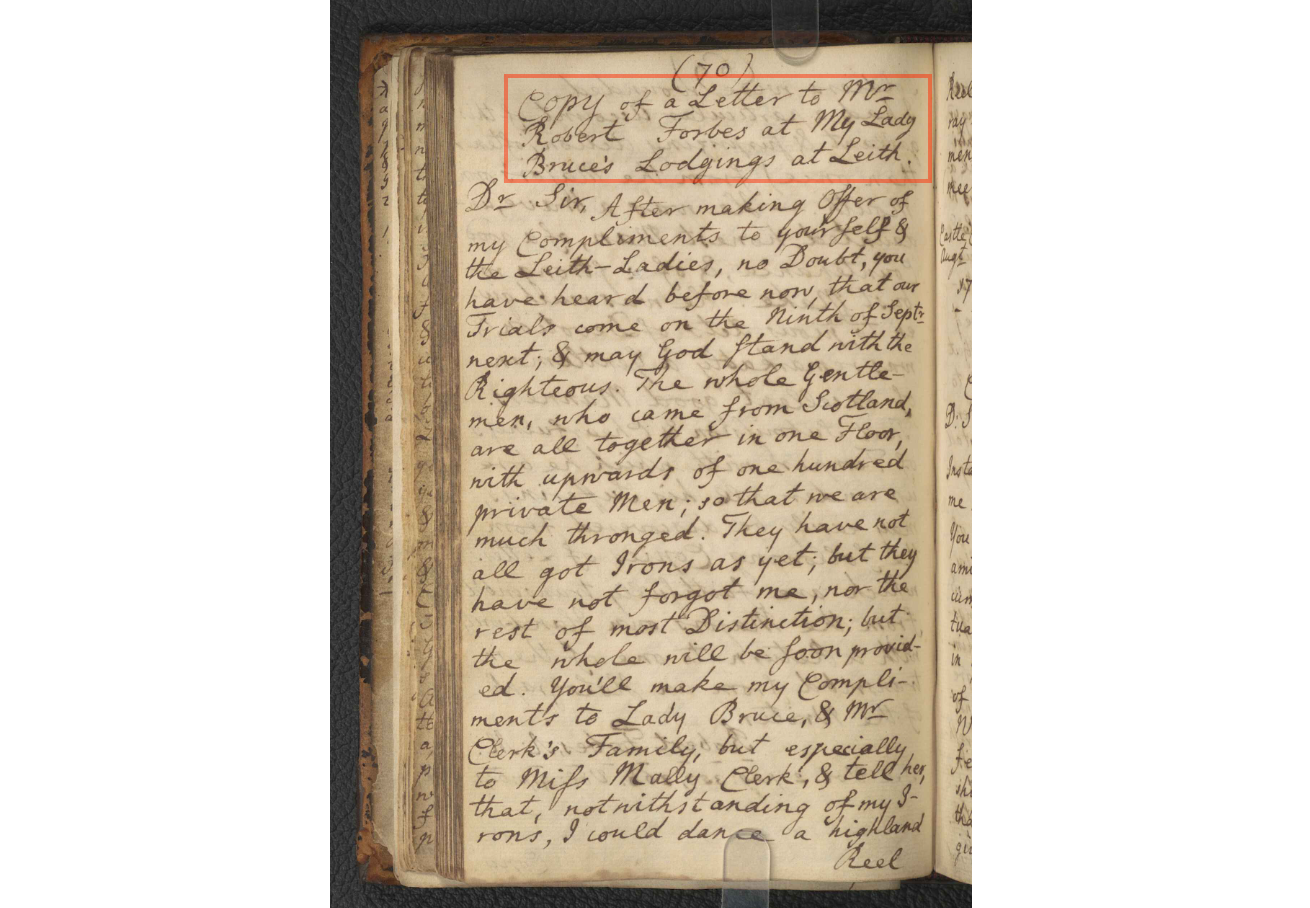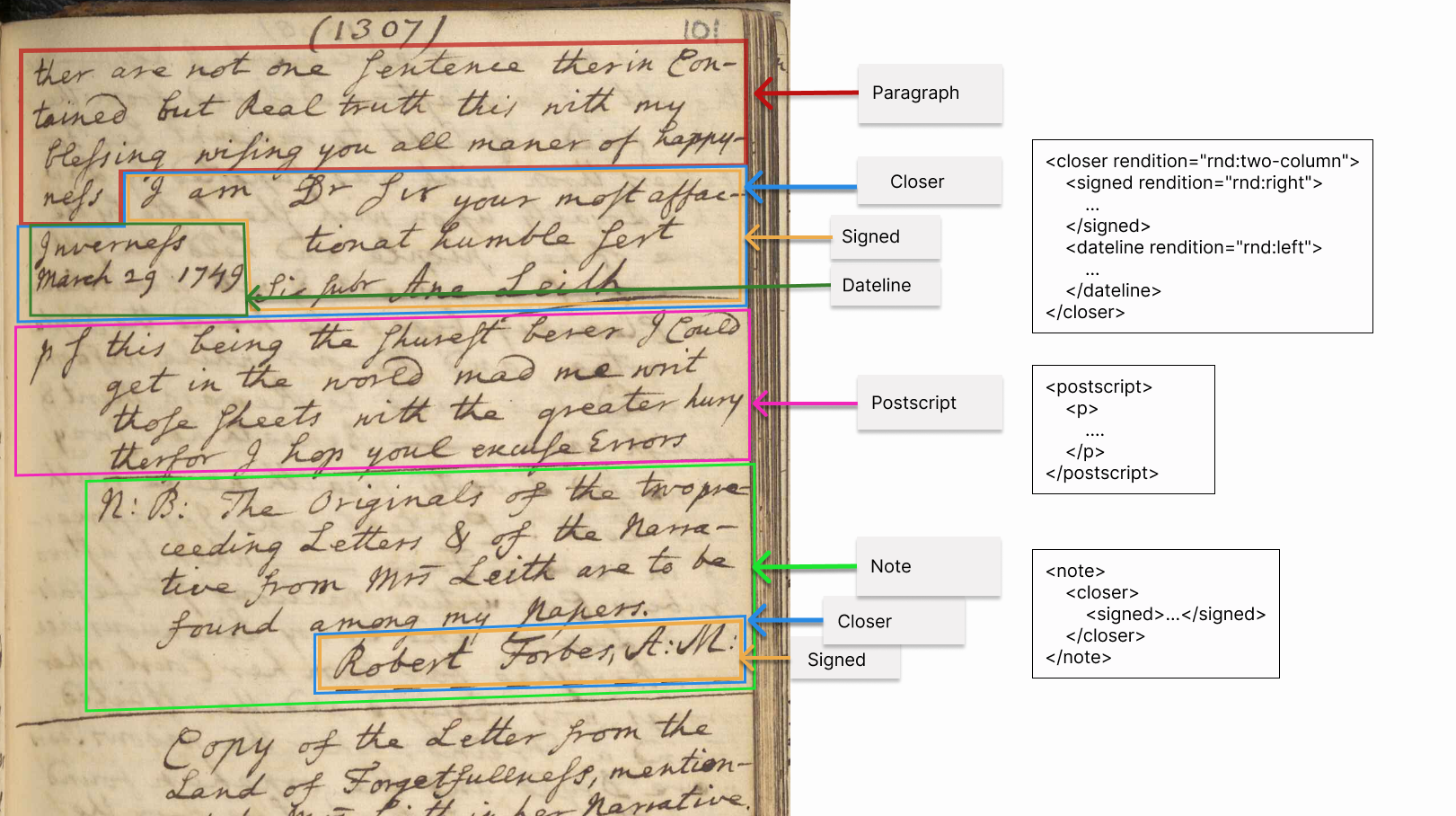Document Structure
Headings
Headings appear at the beginning of an item, usually giving a
title ascribed by Forbes. Not all items have headings—most do, but
there are notable exceptions, especially in the later volumes of the
manuscript.
To encode the heading of a document, use the
head element:
<head>Copy of a Letter to Mr
<lb/>Robert Forbes at My Lady
<lb/>Bruce's Lodgings at Leith.
</head>
Since headings appear inconsistently across the document
collection and are often styled differently, any renditional
information about the heading (i.e. size or alignment) must be
specified using the rendition attribute. For
instance, consider the heading for "Copy of a Letter to Mr
Robert Forbes at My Lady Bruce's Lodgings at Leith":

The heading here is both in larger writing and aligned to the
right, which we can describe by using the "rnd:right" and
"rnd:large" values on
rendition:
<head rendition="rnd:right rnd:large">Copy of a Letter to Mr
<lb/>Robert Forbes at My Lady
<lb/>Bruce's Lodgings at Leith.
</head>
Paragraphs
Openers and Closers
Openers and closers refer to material that tend to begin or
conclude a letter.
opener (opener) groups together dateline, byline, salutation, and similar phrases appearing
as a preliminary group at the start of a division, especially of a letter.
closer (closer) groups together salutations, datelines, and similar phrases appearing as
a final group at the end of a division, especially of a letter.
salute (salutation) contains a salutation or greeting prefixed to a foreword, dedicatory
epistle, or other division of a text, or the salutation in the closing of a letter,
preface, etc.
dateline (dateline) contains a brief description of the place, date, time, etc. of production
of a letter, newspaper story, or other work, prefixed or suffixed to it as a kind
of heading or trailer.
postscript contains a postscript, e.g. to a letter.
Letters often conclude with various features that we want to tag,
including closers with signatures and datelines; postscripts; and
trailing notes written by Forbes.

The above would be encoded like so:
<p>
<!-- [Paragraph begins on the previous page] -->
<lb/><choice><orig>ther</orig><reg>there</reg></choice> are not one sentence therein <w>Con<pc force="weak">-</pc>
<lb/>tained</w> but Real truth this with my
<lb/>blessing <choice><orig>wising</orig><reg>wishing</reg></choice> you all <choice><orig>maner</orig><reg>manner</reg></choice> of <choice><orig><w>happy<pc force="weak">-</pc>
<lb/>ness</w></orig><reg>happiness</reg></choice>
</p>
<closer rendition="rnd:two-column">
<signed rendition="rnd:right">I am <choice><abbr>Dr</abbr><expan>Dear</expan></choice> Sir your most <choice><orig><w>affac<pc force="weak">-</pc>
<lb/>tionat</w></orig><reg>affectionate</reg></choice> humble <choice><abbr>sert</abbr><expan>servant</expan></choice>
<lb/>Sic subr <persName ref="prs:LEITA1"><choice><orig>Ane</orig><reg>Anne</reg></choice> Leith</persName>
</signed>
<dateline rendition="rnd:left"><placeName ref="plc:INVE2">Inverness</placeName>
<lb/>March 29 1749</dateline>
</closer>
<milestone rendition="rnd:right" type="rule" unit="section"/>
<postscript>
<p>p s this being the <choice><orig>shurest</orig><reg>surest</reg></choice> <choice><orig>berer</orig><reg>bearer</reg></choice> I Could
<lb/>get in the world <choice><orig>mad</orig><reg>made</reg></choice> me write
<lb/>those sheets with the greater <choice><orig>hury</orig><reg>hurry</reg></choice>
<lb/><choice><orig>therefor</orig><reg>therefore</reg></choice> I <choice><orig>hop</orig><reg>hope</reg></choice> <choice><orig>youl</orig><reg>you'll</reg></choice> excuse Errors
</p>
</postscript>
<milestone unit="section" type="rule"/>
<note type="lim" place="bottom" anchored="false">N: B: The Originals of the two <w>pre<pc force="weak">-</pc>
<lb/>ceeding</w> Letters & of the <w>Narra<pc force="weak">-</pc>
<lb/>tive</w> from <persName ref="prs:LEITA1">Mrs Leith</persName> are to be
<lb/>found among my Papers.</note>
<closer>
<signed rendition="rnd:right rnd:large rnd:bordered-bottom-dashed">Robert Forbes, A:M:</signed>
</closer>
Two Column Closers
Closers often feature a two-column structure (as above) where
the dateline is floated to the left
and the signed is to the right. To
encode the two column layout, set the
rendition of the
closer to
rnd:two-columnand then use
rnd:leftfor the block floated to the left and
rnd:rightfor the block floated to the right. For instance, the above
Verse
Poems and other verse fragments should be encoded using the
following elements for verse:
l (verse line) contains a single, possibly incomplete, line of verse.
lg (line group) contains one or more verse lines functioning as a formal unit, e.g.
a stanza, refrain, verse paragraph, etc.
All l elements should be enclosed
within an lg; note that you do not
need to include a line beginning element for verse lines.
<lg>
<head rendition="rnd:center">1.</head>
<l>As the Devil was walking o’er Britain’s fair Isle,</l>
<l>George spied in his Phiz a particular Smile,</l>
<!-- [...] -->
</lg>
Indented lines should be encoded using
rendition with the value
"rnd:indent".